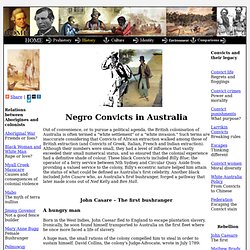

Early Australian bushrangers. McFarlane & Erskine, Gold escort attacked by bushrangers, 187-, print: lithograph.

Image courtesy of the : nla.pic-an8420450. Bushranging - living off the land and being supported by or stealing from free settlers - was either chosen as a preferred way of life by escaped or was a result of the lack of supplies in the early settlements. Australia's bushranging period spanned nearly 100 years, from the first convict bushrangers active from 1790 to the 1860s, through the of the 1860s and 1870s who were able to be shot on sight, to the shooting of the in 1880. While many bushrangers had populist reputations for being 'Robin Hood' figures; some bushrangers were brutal and others harassed the and diggers returning from the goldfields. The popularity of bushrangers and their ethos of 'fight before surrender' was commemorated in and . Escaped convicts Bushranging began soon after the . Black Mary. Michael Howe (bushranger) Untitled Document. Out of convenience, or to pursue a political agenda, the British colonisation of Australia is often termed a "white settlement" or a "white invasion.

" Such terms are inaccurate considering that Convicts of African extraction walked among those of British extraction (and Convicts of Greek, Italian, French and Indian extraction). Although their numbers were small, they had a level of influence that vastly exceeded their small numerical status, and so ensured that the colonial experience had a definitive shade of colour. These black Convicts included Billy Blue; the operator of a ferry service between Nth Sydney and Circular Quay. Aside from providing a valued service to the colony, Billy's eccentric nature helped him attain the status of what could be defined as Australia’s first celebrity. Another black included John Casare who, as Australia's first bushranger, forged a pathway that later made icons out of Ned Kelly and Ben Hall.
John Casare – The first bushranger A hungry man COBLEY, J. Australian Bushrangers. John Dunn (bushranger) Memorial to Nelson at Collector Inscription on memorial to Nelson John Dunn (14 December 1846 – 19 March 1866) was an Australian bushranger.

He was born at Murrumburrah near Yass, New South Wales. He was 19 years old when he was hanged in Darlinghurst Gaol.[1] He was buried in the former Devonshire Street cemetery in Sydney. In May, Hall, Gilbert, and Dunn were proclaimed outlaws; the passing into law the Felons Apprehension Act 1865, which allowed known bushrangers to be shot and killed rather than taken to trial, this put them outside the law and liable to be killed by anyone. Gibert and Dunn on hearing the news of Hall's death headed for Dunn's grandfather's property at Murrumbarrah. Gilbert's grave near Binalong Senior Constable Charles Hales of the Binalong police station received information at 8pm on 12 May 1865 that the two bushrangers had "stuck up" the woolshed near Murrumburrah. The troopers watched for about an hour in the rain. Img2.ranker.com/list_img/1/165850/full/famous-male-bushrangers.jpg%3Fversion%3D1307685636000.
Webzoom.freewebs.com/taskerstreete/photos/null/still%2520215. Bushranger. History[edit] More than 2000 bushrangers are believed to have roamed the Australian countryside, beginning with the convict bolters and drawing to a close after Ned Kelly's last stand at Glenrowan.[3] 1850s: gold rush era[edit] The bushrangers' heyday was the Gold Rush years of the 1850s and 1860s as the discovery of gold gave bushrangers access to great wealth that was portable and easily converted to cash.

Their task was assisted by the isolated location of the goldfields and a police force decimated by troopers abandoning their duties to join the gold rush.[3] George Melville was hanged in front of a large crowd for robbing the McIvor gold escort near Castlemaine in 1853.[3] 1860s to 1870s[edit] Bushranging numbers flourished in New South Wales with the rise of the colonial-born sons of poor, often ex-convict squatters who were drawn to a more glamorous life than mining or farming.[3] Much of the activity in this era was in the Lachlan Valley, around Forbes, Yass and Cowra.[3]